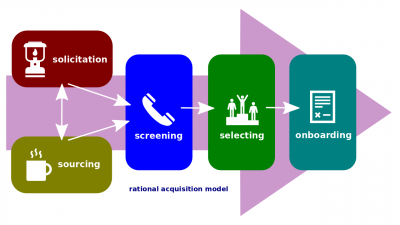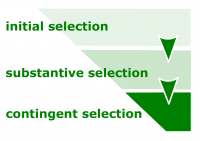Book of Recruitment
Introduction to Recruitment (hereinafter, the Lecture) is a lecture introducing the learners to recruitment and related topics. The Lecture is the third of eight lectures of WorldOpp Orientation (hereinafter, the Orientation).
Contents
Outline
Introduction to Employment is the predecessor lecture.
Recruitment (overview)
- Recruitment. The process of filling job vacancies with people.
- Source selection. The process of selected sources whose resources, credibility and performance is expected to meet the contract/procurement objectives within a competitive range of cost.
- Onboarding. The mechanism of integrating a new employee into the enterprise and its culture.
Statement of recruitment needs
- Job analysis. An assessment that defines jobs and the behaviors necessary to perform them.
- Job description. A written statement that describes a job.
- Credential creep. The process of inflation of the minimum credentials required for a given job and the simultaneous devaluation of the value of diplomas and degrees.
- KSA (or knowledge, skills, and abilities). A series of narrative statements that are particularly required when applying to United States Federal Government job openings. KSAs are used to determine, along with résumés, who the best applicants are when several candidates qualify for a job.
- Work-related knowledge. A body of knowledge applied directly to a particular occupation and/or industry.
- Work-related skill. A set of skills applied directly to a particular occupation and/or industry.
- Work-related ability. A set of capacities applied directly to a particular occupation and/or industry.
Finding potential candidates
- Sourcing. Enterprise efforts undertaken in order to identify and list possible sources, internal and/or external, that are potentially capable to provide the specified organizational resources, as well as potential data sources who are able to provide relevant information on specific acquisitions.
Screening of employment candidates
- Source screening. (1) The evaluation or investigation of a source as part of a methodical survey, to assess suitability for a particular role or purpose; (2) Techniques used for source consideration, reviewing, analyzing, ranking, and selecting the best alternatives for the proposed action.
- Job interview (more narrowly, employment interview). An interview consisting of a conversation between a job applicant and one or more representatives of an employer which is conducted to assess whether the applicant should be hired and, possibly, negotiate conditions of this hiring.
- Employment candidate. Any candidate in a search for employment as an employee.
Services of recruiters
- Recruitment service. Any service related to recruitment.
- Retained recruiter. A recruiter who is paid for the time spent while recruiting regardless of the fact whether qualified sources are identified, hired, or not.
- Contingency recruiter. A recruiter who is paid only when qualified sources are identified and hired.
- Outsourced recruitment. The whole recruitment or its part that is outsourced to another legal entity, either an individual or an organization.
- Employment agency. Any entity that matches employers and employment candidates.
- Staffing firm. Any entity that provides employers with their staffers.
- Temporary staffing provider. Any entity that provides employers with temporary staffers.
- Headhunter (executive search provider or headhunting provider). A specialized recruitment service designed to provide employers with highly qualified employment candidates especially for senior-level and executive jobs.
- Recruitment fee.
- Placement fee. The most typical recruitment fees are collected as a percentage, ranging between 20% to 33% with the average being 25%. The percentage will be taken out of the annual salary of the position you are hiring for. Meaning, the more senior the position in, the more money you’ll end up paying the recruiting firm. As you can see, there is a range, but there’s room for negotiation. If you are hiring for several positions, for instance, you may be able to request a lower percentage. On the other end of the spectrum, with hard to fill positions, the recruiting agency fees may be as high as 33%, because they require much more work.
Flat fee recruitment is not as common in the recruiting world, but it is still an option you should be familiar with, and sometimes it may be the better one. This creates transparency for the services provided by the recruiter and lets you know exactly what services you’d be getting, and at what price. Some firms will agree to flat fee recruiting if they know they’ll be getting additional work from you in the future or if the positions that you’re looking to fill are relatively easy. If you’re looking to work within a very specific budget, and don’t want to be surprised when the bill comes, this may be the way to go.
Introduction to Career Administration is the successor lecture.
Materials
Recorded audio
Recorded video
Live sessions
Texts and graphics
Quiz questions
- Sample true/false questions:
- Recruitment is (not) the process of filling job vacancies with people.
- Recruitment includes (or does not include) sourcing.
- Recruitment includes (or does not include) source screening.
- Recruitment includes (or does not include) source selection.
- Recruitment is (not) the process of finding available and qualified candidates to fill in job vacancies.
- Sourcing is (not) the process of filling job vacancies with people.
- Sourcing is (not) the process of finding available and qualified candidates to fill in job vacancies.
- Source selection is (not) the process of finding available and qualified candidates to fill in job vacancies.
- Source screening is (not) the process of finding available and qualified candidates to fill in job vacancies.
- Source selection is (not) the process of filling job vacancies with people.
- Recruitment is (not) the process of selecting those candidates who offer the best solutions to the organization's needs.
- Sourcing is (not) the process of selecting those candidates who offer the best solutions to the organization's needs.
- Source selection is (not) the process of selecting those candidates who offer the best solutions to the organization's needs.
- Source screening is (not) the process of selecting those candidates who offer the best solutions to the organization's needs.
- Source screening is (not) the process of filling job vacancies with people.
- Recruitment is (not) investigation undertaken in order to find and evaluate the data relevant to credentials of employment candidates.
- Sourcing is (not) investigation undertaken in order to find and evaluate the data relevant to credentials of employment candidates.
- Source selection is (not) investigation undertaken in order to find and evaluate the data relevant to credentials of employment candidates.
- Source screening is (not) investigation undertaken in order to find and evaluate the data relevant to credentials of employment candidates.
- Job interview is (not) a conversation and, possibly, negotiation between an employment candidate and one or more employer representatives.
- Job interview is (not) a part of sourcing.
- Job interview is (not) a part of source screening.
- Job interview is (not) a part of source selection.
- Job analysis is (not) an assessment that defines jobs and the behaviors necessary to perform them.
- Job description is (not) an assessment that defines jobs and the behaviors necessary to perform them.
- Job analysis is (not) a written statement that describes a job.
- Job description is (not) a written statement that describes a job.
- KSA stands (or does not stand) for knowledge, skills, and abilities.
- KSA is (not) a series of narrative statements that describe competencies that the employer is looking for.
- Work-related knowledge is (not) a part of KSA.
- Work-related skills are (not) a part of KSA.
- Work-related abilities are (not) a part of KSA.
- Work-related knowledge is (not) a familiarity, awareness, or understanding of someone or something needed for a particular job.
- Work-related knowledge is (not) the learned ability to carry out a task with pre-determined results relevant to a particular job.
- Work-related knowledge is (not) the capability to perform some function or functions and achieve certain outcomes important to a particular job.
- Work-related skill is (not) a familiarity, awareness, or understanding of someone or something needed for a particular job.
- Work-related skill is (not) the learned ability to carry out a task with pre-determined results relevant to a particular job.
- Work-related skill is (not) the capability to perform some function or functions and achieve certain outcomes important to a particular job.
- Work-related ability is (not) a familiarity, awareness, or understanding of someone or something needed for a particular job.
- Work-related ability is (not) the learned ability to carry out a task with pre-determined results relevant to a particular job.
- Work-related ability is (not) the capability to perform some function or functions and achieve certain outcomes important to a particular job.
- Recruitment service is (not) any service related to recruitment.
- Employment agency is (not) any entity that matches employers and employment candidates.
- Staffing firm is (not) any entity that provides employers with their staffers.
- (Not) every recruiter is an employee of the employer who is hiring.
- (Not) every recruiter is paid for the candidates that he or she sourced, screened, and selected.
- Retained recruiter is (not) paid for the time spent while recruiting.
- Retained recruiter is (not) paid only when qualified sources are identified and hired.
- Contingency recruiter is (not) paid for the time spent while recruiting.
- Contingency recruiter is (not) paid only when qualified sources are identified and hired.



